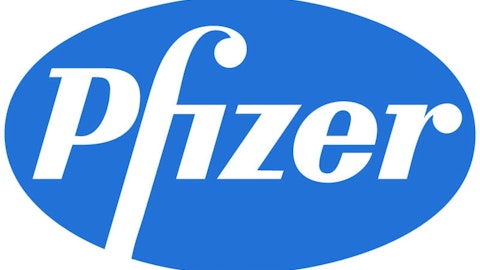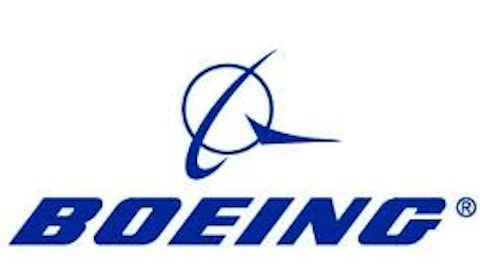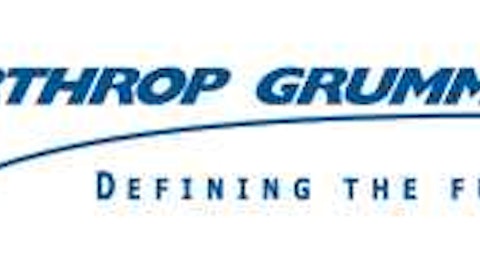In the middle of May 2013, Northrop Grumman Corporation (NYSE:NOC) announced that it intended to repurchase as much as 25% of its total shares outstanding in the next two years. Charlie Munger often advises investors that one of the three things that make investors become successful is investing in cannibals (the companies that keep “eating” themselves. Thus, if Northrop repurchases its shares, its EPS will accelerate and the stock price will eventually follow. Should we consider Northrop as a good buy now? Let’s take a closer look.
U.S. Government accounts for most of its sales
Northrop Grumman Corporation (NYSE:NOC), formed in 1939, is considered one of the leaders in global security, selling most of its products to the U.S. Government, especially the Department of Defense. Most of its operating income, $1.22 billion, or 38.4% of the total 2012 operating income, was generated from the Aerospace Systems segment. The Electronic Systems ranked second, with $1.19 billion in operating income while the Technical Services and Information Systems segment contributed $268 million and $761 million, respectively, in 2012 operating income.
Sales to the U.S. Government, $22.7 billion, accounted for 90% of total sales. Interestingly, most of its revenue derived from cost-type contracts and fixed-price contracts. Around 56% of its sales were cost-type contracts, while the remaining 44% were fixed-price contracts.
A cannibal that pays good dividends
As of March 2013, Northrop Grumman Corporation (NYSE:NOC) has around 235 million total outstanding shares. With the announcement of the plan to buy back 25% of the total shares, the company’s board effectively raised the total authorized amount to $5 billion. In the past five years, Northrop has kept buying back its shares on the market, reducing the total shares from 335 million to only 235 million.
The company has not only returned cash to its shareholders via share buybacks, it has also consistently paid increasing dividends for the past ten years. The dividend rose from $0.80 per share in 2003 to $2.15 per share in 2012. The company is trading at $81.50 per share, with a total market cap of nearly $19.2 billion. The market values the company at only 5.6 times EV/EBITDA.
Is Northrop the best buy compared to its peers?
What I like about Northrop Grumman Corporation (NYSE:NOC) is its low valuation compared to its peers, including General Dynamics Corporation (NYSE:GD) and Lockheed Martin Corporation (NYSE:LMT). General Dynamics, at $76.70 per share, is worth around $27 billion on the market. It has a much higher valuation than Northrop at 7.36 times EV/EBITDA. General Dynamics also generated the majority of its revenue from sales to the U.S. Government. In 2012, sales to the U.S. Government were $20.85 billion, or 66% of the total revenue. However, these sales have been decreasing in the past three years, from 72% to only 66%.
Recently General Dynamics Bath Iron Works, the company’s subsidiary, was awarded a $2.8 billion contract for the building of four Arleigh Burke-class destroyers. Moreover, it also has the option for the fifth ship, bringing the total contract value to $3.5 billion. This contract would provide a positive impact to General Dynamics’ operating performance in the near future.
Lockheed Martin is trading at around $103.60 per share, with a total market cap of nearly $32.95 billion. The market values the company at around 7 times EV/EBITDA. Lockheed Martin also relies on the U.S. Government for most of its businesses. In 2012, it generated around $38.8 billion in total revenue from the U.S. Government, accounting for 82% of total revenue.
In the first quarter of 2013, Lockheed Martin experienced a 2% decline in its revenue to $11.1 billion while its net income rose by as much as 14% to $761 million. In the first quarter, the company spent around $0.5 billion to repurchase around 5.1 million shares. Consequently, its EPS has a bit higher growth at 15% to $2.33 per share, compared to the EPS of $2.03 in the first quarter last year. Investors might feel a bit disappointed, as Lockheed Martin revised its sales outlook. In January, it expected to generate around $44.5 billion to $46 billion in sales. At the end of April, it estimated that its net sales would stay in the low end of the range of the previous outlook. The diluted EPS estimate for the full year stayed the same, in the range of $8.80 to $9.10 per share.
Income investors might like Lockheed Martin the most with its juiciest dividend yield at 4.3%. General Dynamics ranked second with around a 2.9% forward dividend yield, while Northrop offers investors around 3%. However, Northrop Grumman Corporation (NYSE:NOC) seems to have the most potential as it only pays out 28% of its earnings in dividends, while the payout ratio of Lockheed Martin is 50%. In the past twelve months, General Dynamics produced losses, so its payout ratio is not valid.
My Foolish take
Among the three companies, I like Northrop Grumman Corporation (NYSE:NOC) the most because of its lower valuation, the conservative payout ratio and potential share buybacks in the next two years. Investors could benefit when Northrop significantly reduces its share count, pushing up its EPS, which would lead to a share price increase.
Anh HOANG has no position in any stocks mentioned. The Motley Fool owns shares of General Dynamics, Lockheed Martin, and Northrop Grumman.
The article This Defense Stock Could Benefit Shareholders in the Near Term originally appeared on Fool.com.
Copyright © 1995 – 2013 The Motley Fool, LLC. All rights reserved. The Motley Fool has a disclosure policy.





